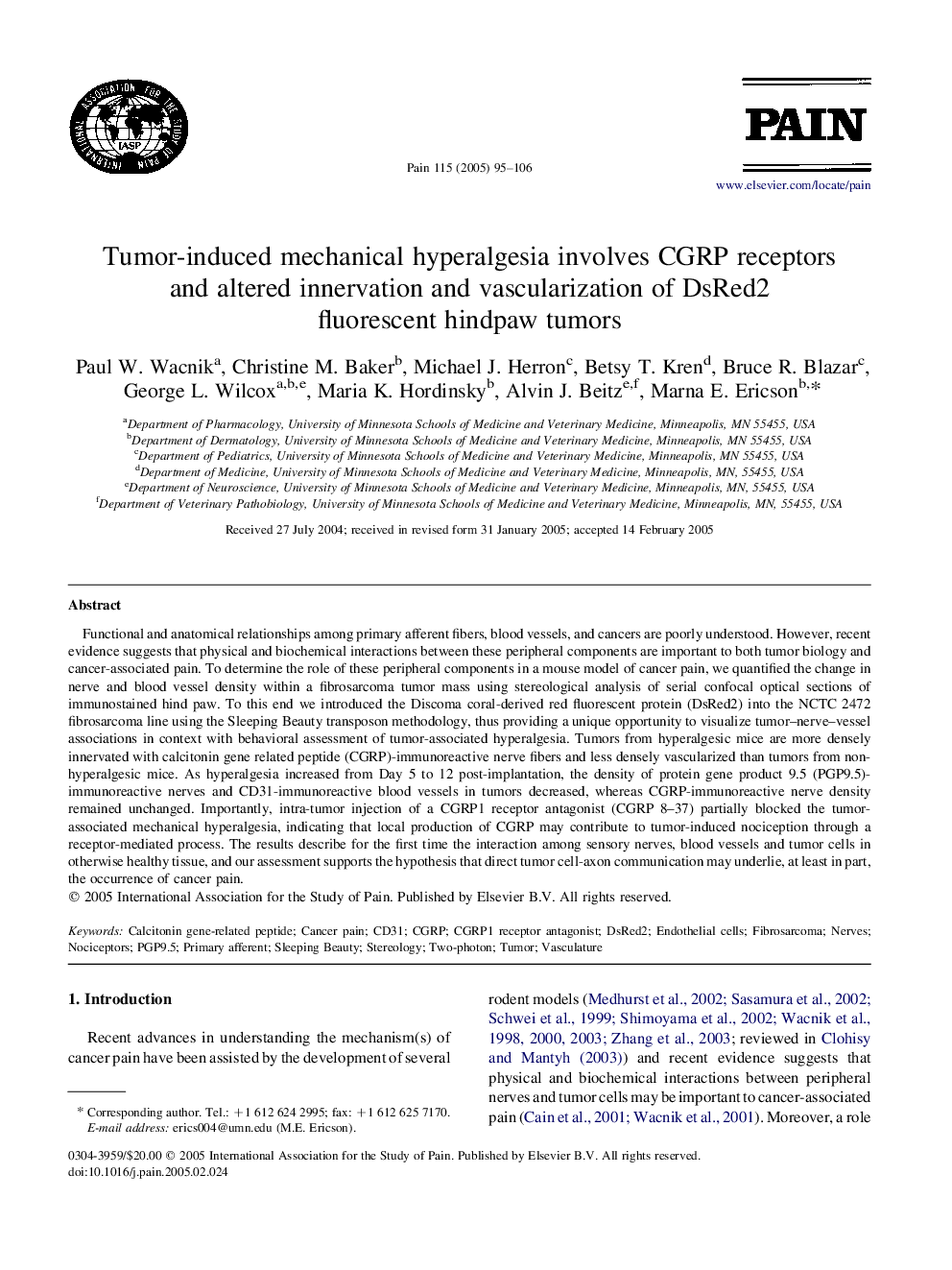| کد مقاله | کد نشریه | سال انتشار | مقاله انگلیسی | نسخه تمام متن |
|---|---|---|---|---|
| 9721049 | 1473270 | 2005 | 12 صفحه PDF | دانلود رایگان |
عنوان انگلیسی مقاله ISI
Tumor-induced mechanical hyperalgesia involves CGRP receptors and altered innervation and vascularization of DsRed2 fluorescent hindpaw tumors
دانلود مقاله + سفارش ترجمه
دانلود مقاله ISI انگلیسی
رایگان برای ایرانیان
کلمات کلیدی
CD31CGRPPGP9.5DsRed2Stereology - استریولوژیNociceptors - اپی نفرینTumor - تومورcancer pain - درد سرطانTwo-photon - دو فوتونSleeping Beauty - زیبای خفتهEndothelial cells - سلولهای اندوتلیالNerves - عصبPrimary afferent - عصبی اولیهFibrosarcoma - فیبراسارکومVasculature - مجاورcalcitonin gene-related peptide - پپتید مرتبط با ژن کلسی تونین
موضوعات مرتبط
علوم زیستی و بیوفناوری
علم عصب شناسی
علوم اعصاب سلولی و مولکولی
پیش نمایش صفحه اول مقاله

چکیده انگلیسی
Functional and anatomical relationships among primary afferent fibers, blood vessels, and cancers are poorly understood. However, recent evidence suggests that physical and biochemical interactions between these peripheral components are important to both tumor biology and cancer-associated pain. To determine the role of these peripheral components in a mouse model of cancer pain, we quantified the change in nerve and blood vessel density within a fibrosarcoma tumor mass using stereological analysis of serial confocal optical sections of immunostained hind paw. To this end we introduced the Discoma coral-derived red fluorescent protein (DsRed2) into the NCTC 2472 fibrosarcoma line using the Sleeping Beauty transposon methodology, thus providing a unique opportunity to visualize tumor-nerve-vessel associations in context with behavioral assessment of tumor-associated hyperalgesia. Tumors from hyperalgesic mice are more densely innervated with calcitonin gene related peptide (CGRP)-immunoreactive nerve fibers and less densely vascularized than tumors from non-hyperalgesic mice. As hyperalgesia increased from Day 5 to 12 post-implantation, the density of protein gene product 9.5 (PGP9.5)-immunoreactive nerves and CD31-immunoreactive blood vessels in tumors decreased, whereas CGRP-immunoreactive nerve density remained unchanged. Importantly, intra-tumor injection of a CGRP1 receptor antagonist (CGRP 8-37) partially blocked the tumor-associated mechanical hyperalgesia, indicating that local production of CGRP may contribute to tumor-induced nociception through a receptor-mediated process. The results describe for the first time the interaction among sensory nerves, blood vessels and tumor cells in otherwise healthy tissue, and our assessment supports the hypothesis that direct tumor cell-axon communication may underlie, at least in part, the occurrence of cancer pain.
ناشر
Database: Elsevier - ScienceDirect (ساینس دایرکت)
Journal: Pain - Volume 115, Issues 1â2, May 2005, Pages 95-106
Journal: Pain - Volume 115, Issues 1â2, May 2005, Pages 95-106
نویسندگان
Paul W. Wacnik, Christine M. Baker, Michael J. Herron, Betsy T. Kren, Bruce R. Blazar, George L. Wilcox, Maria K. Hordinsky, Alvin J. Beitz, Marna E. Ericson,